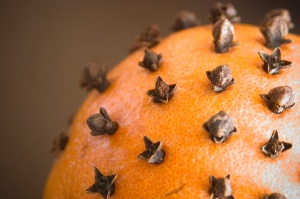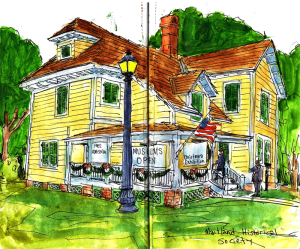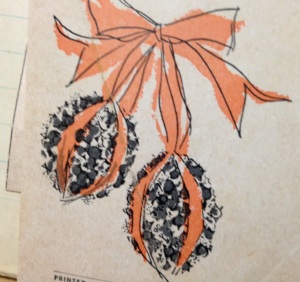
My 1940s directions call for covering fruit with wholes cloves, but others suggest arranging the cloves in lines or patterns.
Years ago, our Florida family made pomander balls for holiday gifts: oranges studded en masse with cloves, rolled in spices, and hung from ribbons.
These fragrant fruit-and-spice pomander balls were a time-honored way to add a hint of fragrance to your home, long before companies attempted to manufacture good smells and put them in a spray can.
The Old Farmer’s Almanac says the practice went back as far as medieval times. (http://www.almanac.com/content/seasonal-crafts-how-make-orange-pomanders)

The ladies are discussing “that Oxydol sparkle” on the back of a recipe in Mom’s old book of clippings.
The directions my mother used, clipped from an unidentified magazine, are still taped in the black ledger book where she began to collect recipes and household tips in the 1940s.
They note that the pomanders can also be made with apples, lemons, or limes. We usually used oranges.
The full directions suggest storing the pomander for three or four weeks to dry, but in Florida, the following steps for quick preparation seem best.
1. Spread lots and lots of whole cloves on waxed paper.
2. With a small nail or sturdy toothpick, pierce holes in the skin of the fruit, from one end to the other and as close together as possible without splitting the skin.
3. Now stick whole cloves in the holes. Make additional holes where needed; fill the holes with cloves, so that the fruit is covered with them (or feel free to use less, as picture at top).
4. Combine equal amounts of ground cinnamon and powdered orrisroot, or use a mixture of spices with orissroot.
The recipe at Old Farmer’s Almanac suggests 1 teaspoon ground cinnamon, 1 teaspoon ground cloves, 1 tablespoon ground nutmeg, 1 tablespoon allspice, and 1/4 cup powdered orrisroot.
5. Roll the clove-studded fruit in your spices until the fruit is coated. Our 1940s directions suggest using ground cloves with a lemon and ground nutmeg with a lime.
5. After fruit is rolled in the mixture, place in a shallow baking pan and bake at 300 degrees F for 4 hours. Cool.
6. To make a hanger, tie a long narrow ribbon securely around the fruit, making a knot at top. Leave about 4 inches of ribbon for a loop, and tie with ribbon ends with a bow. The 1940s directions suggest wrapping the ball in “metallic mesh or hat veiling, and it’s ready for Santa to deliver.”
I seem to be all out of hat veiling.

The Waterhouse Museum by artist and journalist Thomas Thorspecken. See http://www.analogartistdigitalworld.com/2011/01/maitland-historical-society.html
The orrisroot is the key ingredient, and acts as a fixative. Our directions say to get it from a drugstore, but, like the hat veiling, that’s no longer workable for most of us. A health-food store that sells bulk spices is a better bet.
A few years ago, during a holiday visit to the Waterhouse Museum — a lovely Victorian house in Maitland, Florida — I remembered the pomanders because some were on display, along with other natural crafts.
Even if we don’t make pomander balls, it’s fun to think about them and those rich, natural aromas of citrus and cloves. For more on the Waterhouse, visit http://artandhistory.org/waterhouse-museum/
